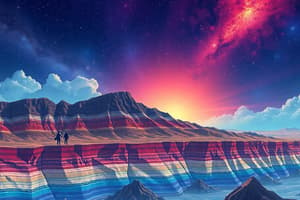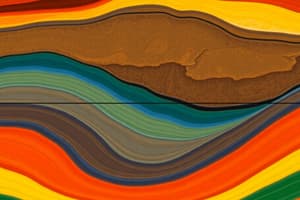Podcast
Questions and Answers
What is the primary purpose of the geologic time scale?
What is the primary purpose of the geologic time scale?
- To organize Earth's history into manageable parts. (correct)
- To determine the composition of Earth's core.
- To predict future volcanic eruptions.
- To measure the speed of tectonic plate movement.
Geologic processes only occur rapidly and do not cause changes over long periods.
Geologic processes only occur rapidly and do not cause changes over long periods.
False (B)
Name three geologic processes that constantly reshape Earth's surface.
Name three geologic processes that constantly reshape Earth's surface.
Weathering, erosion, tectonic plate motion.
The movement of tectonic plates is an example of geologic change that occurs at a rate of a few ______ each year.
The movement of tectonic plates is an example of geologic change that occurs at a rate of a few ______ each year.
Match each geologic event with its approximate time of occurrence:
Match each geologic event with its approximate time of occurrence:
What is the rock record primarily composed of?
What is the rock record primarily composed of?
Fossils can only provide information about the relative ages of rock layers and not about past environments.
Fossils can only provide information about the relative ages of rock layers and not about past environments.
Briefly describe how scientists correlate sequences of matching fossils from different locations.
Briefly describe how scientists correlate sequences of matching fossils from different locations.
A supervolcano eruption leaves behind cooling ash that forms deposits of rock called ______.
A supervolcano eruption leaves behind cooling ash that forms deposits of rock called ______.
Match evidence types with what they provide to Earth's timeline construction:
Match evidence types with what they provide to Earth's timeline construction:
If the oldest rock in an undisturbed sequence is shale and the youngest is igneous rock, what can be said about the layers in between?
If the oldest rock in an undisturbed sequence is shale and the youngest is igneous rock, what can be said about the layers in between?
In undisturbed rock layers, the top layer is usually the oldest.
In undisturbed rock layers, the top layer is usually the oldest.
What does the presence of marine fossils in a rock layer indicate about the area's past?
What does the presence of marine fossils in a rock layer indicate about the area's past?
Fossils of extinct organisms are generally ______ than fossils that resemble living organisms.
Fossils of extinct organisms are generally ______ than fossils that resemble living organisms.
Match the following terms with their correct place in the geologic time scale:
Match the following terms with their correct place in the geologic time scale:
Approximately what percentage of Earth's 4.6-billion-year history does the Precambrian time period represent?
Approximately what percentage of Earth's 4.6-billion-year history does the Precambrian time period represent?
Divisions in the geologic time scale are equal in length, similar to how time is organized on a clock.
Divisions in the geologic time scale are equal in length, similar to how time is organized on a clock.
Name two factors that can cause geologic changes on Earth.
Name two factors that can cause geologic changes on Earth.
Scientists can use the rock and ______ record to piece together Earth's past.
Scientists can use the rock and ______ record to piece together Earth's past.
Match the era to well-known living things that developed during that time:
Match the era to well-known living things that developed during that time:
What does the presence of similar fossils in different rock sequences around the world suggest?
What does the presence of similar fossils in different rock sequences around the world suggest?
Scientists only analyze present geologic processes and completely disregard past environments to understand Earth's history.
Scientists only analyze present geologic processes and completely disregard past environments to understand Earth's history.
What are geologic events, such as asteroid impacts and tectonic plate movements recorded in?
What are geologic events, such as asteroid impacts and tectonic plate movements recorded in?
Rocks and fossils can be identified as having existed ______ or ______ these events occurred.
Rocks and fossils can be identified as having existed ______ or ______ these events occurred.
Match the following eras to the most characteristic events during those eras:
Match the following eras to the most characteristic events during those eras:
What information do scientists take into account when reconstructing Earth's geologic past?
What information do scientists take into account when reconstructing Earth's geologic past?
Absolute dating can only determine the range of time rocks existed, but cannot provide the exact date.
Absolute dating can only determine the range of time rocks existed, but cannot provide the exact date.
What can appearances of new organisms or disappearances of previously existing organisms in the fossil record be related to?
What can appearances of new organisms or disappearances of previously existing organisms in the fossil record be related to?
The fossil record is a compilation of all of Earth's known fossils and the information they provide about Earth's ______.
The fossil record is a compilation of all of Earth's known fossils and the information they provide about Earth's ______.
Match the time period to a rock type that often occurs during this period:
Match the time period to a rock type that often occurs during this period:
Flashcards
Geologic Processes
Geologic Processes
Weathering, erosion, and plate tectonics constantly change Earth's surface.
Rate of Geologic Change
Rate of Geologic Change
The wearing down of the Appalachian Mountains shows the slow rate of geologic change.
Rapid Geologic Change
Rapid Geologic Change
A meteorite impact can cause rapid global changes.
Clues in rocks and fossils
Clues in rocks and fossils
Signup and view all the flashcards
Rock Record
Rock Record
Signup and view all the flashcards
Benchmarks
Benchmarks
Signup and view all the flashcards
Fossil Use
Fossil Use
Signup and view all the flashcards
Geologic Time Scale
Geologic Time Scale
Signup and view all the flashcards
Unequal Time Divisions
Unequal Time Divisions
Signup and view all the flashcards
Paleoartist
Paleoartist
Signup and view all the flashcards
Precambrian Time
Precambrian Time
Signup and view all the flashcards
Phanerozoic Eon
Phanerozoic Eon
Signup and view all the flashcards
Eras
Eras
Signup and view all the flashcards
Origin of Oxygen
Origin of Oxygen
Signup and view all the flashcards
Mesozoic Era
Mesozoic Era
Signup and view all the flashcards
Cenozoic Era
Cenozoic Era
Signup and view all the flashcards
Study Notes
- The geologic time scale is used to organize Earth's history.
- It is continually updated as new rock and fossil evidence is discovered.
Modeling Earth's History
- Earth's history can be represented by a 12-month calendar to conceptualize the vastness of geologic time.
Geologic Change
- Geologic processes like weathering, erosion, and tectonic plate motion constantly reshape Earth over millions of years.
- Present-day geologic processes can offer insights into those of the past, such as volcanoes erupting and glaciers carving valleys.
- Some changes can happen relatively quickly, such as meteorite impacts and volcanic eruptions. Other processes are much slower.
- The movement of tectonic plates is slow, but can build tall mountain ranges and form ocean basins over millions of years.
Scales of Time
- The Himalayan Mountains, for example, grow at a rate of about 1 cm per year due to tectonic plate movement.
Compiling Evidence of Earth's Past
- Rocks and fossils clues about how they formed, past conditions and environments.
- Comparing rocks globally helps scientists organize the timing of events in Earth's history.
- The rock record contains major geologic events, used as benchmarks for specific time periods.
- Absolute dating of events, like a supervolcano eruption, provides evidence for the ages of surrounding rocks and fossils.
- Volcanic tuff deposits from a supervolcano in Wyoming are dated to 640,000 years ago.
Fossil Evidence
- Fossils, provide clues about Earth's past.
- The fossil record catalogues all known fossils and their Earth's history information.
- Matching fossil sequences globally helps apply relative dating principles to determine life changes over time.
Analysis of Rock Layers
- Field geologists analyze undisturbed rock sequences to describe geologic history.
- The oldest rock in a study location is shale, while the youngest is igneous rock.
- There was a period of no rock deposition or active erosion from 450 to 120 million years ago.
- The area was covered by a shallow sea between 120 and 50 million years ago, evidenced by sea turtle fossils.
- Brittle stars lived long before the sea turtle.
Correlating Rock Sequences
- Fossil correlations in undisturbed rock sequences can construct diagrams and interpret the geological history of a region.
- Extinct fossils are generally older than fossils resembling living organisms.
Organizing Earth's History
- Rock and fossil records offers evidence of change, construct timelines that describe Earth's history.
- Geologic timelines can detail geological events or focus on life changes.
- The oldest mineral is 4 billion years old.
- First flowering plants appeared 145 million years ago.
- Dinosaurs became extinct 65 million years ago.
- The supercontinent Pangaea broke up 220 million years ago.
Divisions in Geologic Time
- Earth's history is divided into four eons, eras, periods, and epochs
- Divisions in the geologic time scale are not equal; it is based on major events like extinctions.
- Divisions differ from how time is organized on a clock due to these major events and changes in Earth's history.
- Precambrian time represents almost 90% of Earth's 4.6-billion-year history.
Evidence
- Photosynthetic organisms released oxygen into shallow iron-rich seas over 3 billion years ago.
- Photosynthetic sea creatures existed about 2 billion years ago, enriching the air with oxygen after the seas' iron was depleted.
- Crinoids flourished during the Paleozoic Era, anchored to the ocean floor, and some species exist now.
Examples
- Pterodactylus (Late Jurassic) was a flying meat-eating reptile.
- Horse-like mammal fossil from Paleogene time.
- Members of the genus Homo appeared about 200,000 years ago.
Studying That Suits You
Use AI to generate personalized quizzes and flashcards to suit your learning preferences.




